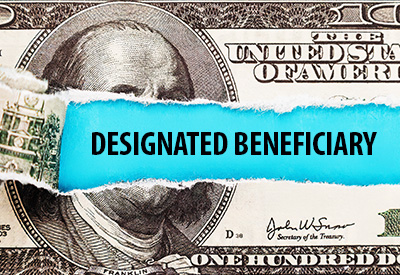Estate planning often involves complex legal documents, difficult financial decisions and tedious formalities, requiring careful consideration of family dynamics, asset distribution and tax strategies. Among estate planning options, payable-on-death designations stand out as seemingly simple solutions for transferring bank accounts to heirs. Think of a PoD designation as creating a direct pipeline between your bank account and your chosen beneficiary – but one that only opens after your passing. Unlike traditional inheritance methods that require probate court supervision, PoD designations operate more like a pre-arranged handoff, allowing for smooth asset transfer when the time comes.
How do PoD bank accounts work after death?
The mechanics of PoD accounts are straightforward, yet understanding their operation helps explain both their appeal and limitations. During your lifetime, the account functions exactly like any other bank account – you maintain complete control over your funds, you can withdraw or deposit at will, and you can even change beneficiaries without their knowledge or consent. When you pass away, the transition happens quickly. Your designated beneficiary presents your death certificate and their identification to the bank, and the funds transfer to them immediately.
What are the benefits of PoD designations for beneficiaries?

The immediate aftermath of losing a loved one can create a burdensome financial situation. Precisely when families need quick access to funds, traditional inheritance methods often freeze assets in lengthy probate proceedings. This is where PoD designations reveal their unique value, acting as a financial bridge during one of life's most challenging transitions.
Consider this common scenario: A family needs to make funeral arrangements within days of a loved one's passing, facing immediate costs that they expect to exceed $10,000. Meanwhile, standard bank accounts become temporarily inaccessible during probate, which can take six months to a year or more to complete. PoD accounts, however, operate differently. Within days – sometimes even hours – of presenting a death certificate, beneficiaries can access funds to address these pressing needs.
The financial advantages extend beyond funeral and related expenses. PoD beneficiaries can quickly access funds to:
- Maintain mortgage or rent payments on the deceased's residence.
- Continue utility services and property maintenance.
- Pay outstanding medical bills or other final expenses.
- Cover ongoing care costs for dependent family members.
- Handle immediate tax obligations.
- Retain professional assistance for estate matters.


But perhaps equally important is the emotional benefit. During a time of grief, the last thing families need is the added stress of dealing with complex legal procedures or worrying about financial obligations. PoD designations offer what might be called "emotional efficiency" – they minimize administrative burdens when beneficiaries are least equipped to handle them. Unlike probate assets, which often require multiple court appearances and extensive documentation, PoD transfers typically require just two key documents: a death certificate and valid identification.
The cost savings can be substantial. While probate often involves attorney fees ranging from 3% to 8% of the asset's value, plus court costs and executor fees, PoD transfers typically incur no additional expenses. This means a $100,000 bank account could save beneficiaries between $3,000 and $8,000 in legal fees alone when transferred through a PoD designation rather than probate.
The benefit of privacy also deserves mention. Unlike probate proceedings, which become public record, PoD transfers remain private transactions between the financial institution and the beneficiary. This confidentiality can be particularly valuable for families who prefer to keep their financial matters private or in situations where public knowledge of an inheritance might create complications.
Moreover, PoD designations offer flexibility during the account owner's lifetime. Unlike irrevocable trusts or joint accounts, which can limit your control or create immediate rights for others, PoD arrangements preserve your complete autonomy while you're alive. You maintain exclusive control over your funds, can change beneficiaries at will and can even close the account without notifying the designated beneficiary.
Understanding these benefits helps explain why PoD designations have become increasingly popular, particularly for those seeking to provide immediate support for their loved ones while maintaining lifetime control over their assets.
Who should not use PoD beneficiary designations?

PoD designations, while appealing in their simplicity, can create significant problems for certain individuals and situations. Understanding these scenarios helps prevent unintended consequences that could undermine your estate planning goals. There are several specific situations where PoD designations might do more harm than good.
For beneficiaries with special needs, a PoD designation could be catastrophic. Consider Sarah, who receives Supplemental Security Income (SSI) and Medicaid. If she inherits $50,000 through a PoD account, she would immediately become ineligible for these crucial benefits. Instead of helping Sarah, the inheritance could disrupt her entire support system. A special needs trust is an option would allow the funds to supplement rather than replace government benefits.
Young or financially inexperienced beneficiaries present another challenge. Take the case of Marcus, who inherited $100,000 through a PoD account at age 19. Without any restrictions or guidance mechanisms, he spent the entire amount within six months on a luxury car and entertainment. His grandfather had intended the money to fund Marcus' college education, but PoD designations provide no way to ensure funds are used as intended.
Beneficiaries struggling with addiction require particularly careful consideration. A sudden influx of unrestricted funds could enable destructive behaviors rather than provide genuine help. In these cases, a trust with provisions for addiction treatment and controlled distributions would better serve the beneficiary's true needs.
How do PoD accounts compare to living trusts?
When weighing estate planning options, it's helpful to compare PoD accounts with revocable living trusts. Think of PoD designations as basic light switches – they're either on or off, with no dimming capability. Revocable living trusts, by contrast, work more like sophisticated smart home systems, offering numerous controls and conditions for asset distribution. While PoD designations excel in simplicity and immediate transfer, trusts provide flexibility and control that many estate planning situations require.
Here's how PoD accounts and trusts differ in practical terms:
- Distribution control. PoD accounts offer an immediate, all-at-once transfer. Trusts can specify conditions (age, education, marriage) and create scheduled distributions or tie inheritance to specific achievements or behaviors.
- Flexibility during life. PoD accounts are limited to changing beneficiaries or closing the account. Revocable living trusts can be modified to address changing family circumstances, add beneficiaries or adjust distribution terms.
- Protection mechanisms. None are available once funds from a PoD account are transferred. Trusts can include spendthrift provisions, creditor protection and divorce protection.
- Tax planning. PoD accounts have limited tax planning opportunities; a trust can incorporate sophisticated tax minimization strategies and generation-skipping provisions.
What are common PoD designation mistakes to avoid?
The seemingly straightforward nature of PoD designations often masks complex pitfalls that can create significant problems. Understanding these common mistakes helps prevent unintended consequences that might not surface until it's too late to correct them.
Professional estate planners routinely encounter these problematic scenarios:
- Medicaid planning oversight. A daughter designates her elderly mother as a PoD beneficiary, not realizing this will disrupt her mother's pending Medicaid application for nursing home care. Proper planning would have directed these funds to a Medicaid-compliant trust instead.
- Unbalanced estate distribution. Parents set up PoD accounts for their children individually but fail to coordinate these designations with their overall estate plan. When combined with other inheritances, this creates significant disparities between siblings, leading to family conflicts.
- Business succession complications. A business owner uses PoD designations for company operating accounts without considering how this might affect business continuity. When they pass away, immediate access to these funds by personal beneficiaries could disrupt business operations.
How do multiple PoD beneficiaries impact estate distribution?

The complexity of PoD designations increases with multiple beneficiaries, creating potential scenarios that could undermine your estate planning intentions. Understanding these dynamics is crucial for preventing unintended consequences.
Consider this real-world example: John designates his three children – Michael, Sarah and David – as equal PoD beneficiaries on his $300,000 savings account. Sarah predeceases John, leaving behind two children of her own. When John passes away, many assume Sarah's $100,000 share would go to her children. Instead, Michael and David each receive $150,000, while Sarah's children receive nothing. This "survivor-takes-all" approach can create generational wealth disparities that the account owner never intended.
Another concern is that when one beneficiary has special needs, their share of a PoD account could disrupt crucial government benefits, while other beneficiaries face no such complications. In addition, multiple beneficiaries living in different states may face varying state tax consequences and practical challenges in accessing their inheritance.
Conclusion
The decision to use a PoD designation should be part of a broader estate planning strategy. Consider consulting with a qualified estate planning attorney who can help evaluate whether PoD designations align with your overall goals and circumstances. Remember that estate planning isn't a one-size-fits-all proposition – what works perfectly for one person might be inappropriate for another.
When evaluating PoD designations, consider these key factors:
- Your beneficiary's financial responsibility and life circumstances.
- The potential impact on government benefits.
- The need for immediate access to funds after your passing.
- The complexity of your estate and overall distribution wishes.
Questions to ask yourself before establishing a PoD designation:
- Will my estate have sufficient liquid assets to cover final expenses without this account?
- Is my intended beneficiary financially responsible enough to handle a lump sum inheritance?
- Could this designation potentially conflict with my other estate planning documents?
- Would a more structured inheritance through a trust better serve my goals?
By carefully considering these factors and understanding both the benefits and limitations of PoD designations, you can make an informed decision about whether this estate planning tool aligns with your goals and circumstances. Remember that estate planning is not a one-time event – regular reviews and updates ensure your plan continues to meet your needs and objectives as circumstances change.



